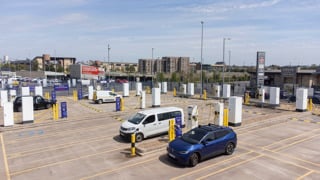By Lee Feihn, UK business developer, NewMotion
Earlier this year, Shell’s CEO announced that he will be switching from a diesel car to a plug-in Mercedes-Benz S500e.
It wasn’t the first or last announcement in 2017 that made the world sit up and take notice of EVs.
In the UK, Norway and France there were announcements to ban the sale of new diesel and petrol cars by 2040, in a bid to encourage people to buy electric.
There are at least ten other countries that also set sales targets for electric cars.
Major car manufacturers also got in on the action. What does this all mean for 2018, what can we expect to see?
Rise of residential and workplace charge points
In February 2017, a £2.5 million fund was launched by the Energy Saving Trust to help local authorities install on-street charge points for residential EV drivers.
As it stands 40% of the population have no off-street parking, but residential charge points provide the opportunity for these people to consider an EV.
For those with a driveway, the ‘OLEV’ government grant provided by the Office for Low Emission Vehicles provides £500 off the cost of purchasing & installing a home charge point.
As of 28th November 2017, there were 4,918 locations in the UK, which have a public charge point installed including workplaces. This is only set to grow in 2018.
How E-Mobility is reshaping the automotive market
E-bikes
E-bikes are well-established in some EU countries, yet relatively new to the UK. However, congestion, dangerous levels of pollution, and the cost of regular bikes are forcing the UK population to look for alternatives.
For example, global delivery firm UPS has begun trialling a new electric-powered bike trailer on the streets of London and Pittsburgh.
Even the major carmakers are getting on board, like BMW, which has been designing e-bikes for decades. 2018 could see a major shift in the thinking of this form of transport, especially in big cities across the UK.
E-Trucks
In the shift towards EVs, vehicle manufacturers are increasingly developing an EV proposition for commercial vehicles, such as trucks, transit vans and taxis.
An often-overlooked segment, this area has big growth potential given tightening pollution restrictions in urban areas and the rise in e-commerce.
Charge points at petrol stations
To have charge points at petrol stations sounds like a nice-to-have to EV drivers, but 2017 saw Shell announce that it would install EV chargers at a handful of its UK petrol stations, allowing users to charge 80% of their battery in half an hour.
The chargers were installed in London, Surrey and Derby, and NewMotion’s charge card will be accepted on these fast chargers in the near future.
BP is also in talks with electric car manufacturers over installing charge points across its UK petrol station empire.
Comprehensive infrastructure improvements
The Autumn Statement revealed the government will invest a much needed £400 million into improving charging infrastructure in the UK.
There will also be a further £100 million invested in Plug-In-Car-Grant. The government’s main objective here is to future-proof the UK’s EV charging infrastructure to ensure it can withstand the expectant growth and uptake of EV driving.
The infrastructure improvement is welcome news with more investment expected to come in 2018, as the 2040 diesel ban gets nearer.
The Creation of an Open Roaming Network
To roam is to move or travel aimlessly or unsystematically especially over a wide area. Bring that back to EVs, and more specifically charging, roaming can often be referred to as interoperability.
2018 should finally see the UK’s EV driving population be introduced to a solution that allows them to enjoy an open network, receiving one bill from their charge provider.
Operators should be able to group together and divide up these costs between themselves behind the scenes, offering a more seamless service to users.
2017 has seen the EV industry rise to prominence, with no signs of this waning in 2018.
The conversation has moved from ‘should I buy an EV?’ to ‘when will I buy an EV?’.
Aided by investments, incentives and major corporation buy in, the question now isn’t about when it will come, but more – are we ready?


















Login to comment
Comments
No comments have been made yet.